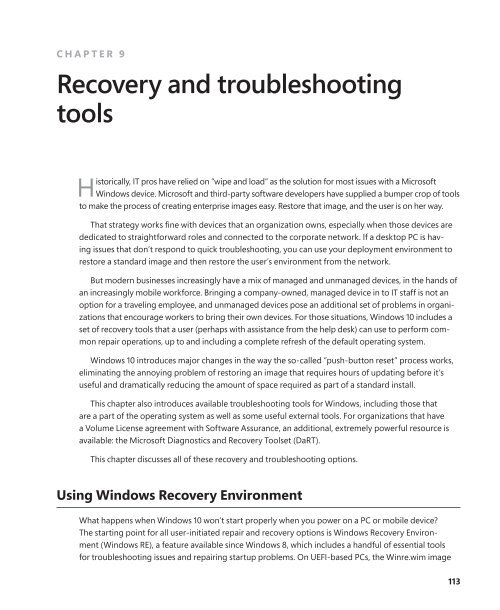MICROSOFT_PRESS_EBOOK_INTRODUCING_WINDOWS_10
Create successful ePaper yourself
Turn your PDF publications into a flip-book with our unique Google optimized e-Paper software.
CHAPTER 9<br />
Recovery and troubleshooting<br />
tools<br />
Historically, IT pros have relied on “wipe and load” as the solution for most issues with a Microsoft<br />
Windows device. Microsoft and third-party software developers have supplied a bumper crop of tools<br />
to make the process of creating enterprise images easy. Restore that image, and the user is on her way.<br />
That strategy works fine with devices that an organization owns, especially when those devices are<br />
dedicated to straightforward roles and connected to the corporate network. If a desktop PC is having<br />
issues that don’t respond to quick troubleshooting, you can use your deployment environment to<br />
restore a standard image and then restore the user’s environment from the network.<br />
But modern businesses increasingly have a mix of managed and unmanaged devices, in the hands of<br />
an increasingly mobile workforce. Bringing a company-owned, managed device in to IT staff is not an<br />
option for a traveling employee, and unmanaged devices pose an additional set of problems in organizations<br />
that encourage workers to bring their own devices. For those situations, Windows <strong>10</strong> includes a<br />
set of recovery tools that a user (perhaps with assistance from the help desk) can use to perform common<br />
repair operations, up to and including a complete refresh of the default operating system.<br />
Windows <strong>10</strong> introduces major changes in the way the so-called “push-button reset” process works,<br />
eliminating the annoying problem of restoring an image that requires hours of updating before it’s<br />
useful and dramatically reducing the amount of space required as part of a standard install.<br />
This chapter also introduces available troubleshooting tools for Windows, including those that<br />
are a part of the operating system as well as some useful external tools. For organizations that have<br />
a Volume License agreement with Software Assurance, an additional, extremely powerful resource is<br />
available: the Microsoft Diagnostics and Recovery Toolset (DaRT).<br />
This chapter discusses all of these recovery and troubleshooting options.<br />
Using Windows Recovery Environment<br />
What happens when Windows <strong>10</strong> won’t start properly when you power on a PC or mobile device?<br />
The starting point for all user-initiated repair and recovery options is Windows Recovery Environment<br />
(Windows RE), a feature available since Windows 8, which includes a handful of essential tools<br />
for troubleshooting issues and repairing startup problems. On UEFI-based PCs, the Winre.wim image<br />
113


